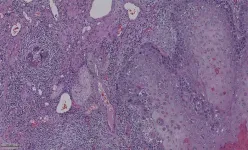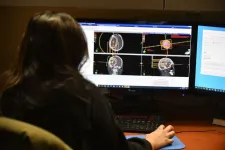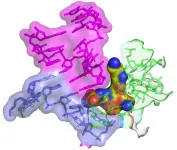You’ve got some nerve
Researchers have known about the relationship between nerve density and oral cancer. Now, a new metric could help bring these findings into the clinic.
2023-05-16
(Press-News.org)
Researchers at the University of Michigan Rogel Cancer Center and the School of Dentistry identified a new metric to articulate the relationship between nerve density and oral cancer. The study, published in Clinical Cancer Research, a journal of the American Association for Cancer Research, investigated normalized nerve density to translate previous mechanistic studies into a context that could be used in the clinic.
“We are recognizing more and more that there's a very dynamic interaction between nerves and cancer cells in the tumor microenvironment,” said Nisha D’Silva, B.D.S., M.S.D, Ph.D., Donald Kerr Endowed Collegiate Professor of Oral Pathology and senior author.
The team looked at how the density of nerves within a tumor tied with the tumor's growth. The oral cavity has several regions, each with different functions. The way each area receives nerves is distinct; the nerves in the inside of the cheek have a different role and are fewer than nerves on the tongue. Given these variations, looking at nerve density of the tumor without considering the normal innervation of the different areas in the oral cavity and each individual’s variation to assess whether a tumor is aggressive leaves an inaccurate picture.
To account for this, the team created a standardized metric for nerve density to clarify the variation in distribution of nerves in the oral cavity, called normalized nerve density, and showed its importance in tumor progression. Most of the work was done with human tissue and the team then validated the findings using a mouse model.
They used adjacent tissue to compare and determine a “normalized” density for different regions in the oral cavity. “We showed that tumors with high normalized nerve density seem to be associated with poor survival for patients with tongue cancer, which is the most common type of oral cancer,” D’Silva explained. “We also found that patients with high normalized nerve density and a smaller distance between the nerve and the tumor have poorer outcomes.”
Additionally, the team explored the use of artificial intelligence to measure normalized nerve density, which could facilitate the use of this metric in clinical practice.
A challenge with treating oral cavity cancer is their tendency to recur. “The question becomes, how can you look for factors that could contribute to progression? How can you use nerve features to figure out which cancers will behave more aggressively?” D’Silva explained. She says if researchers can figure out which cancers will behave more aggressively from the outset, then they could treat the tumors more aggressively from the beginning. Normalized nerve density provides researchers with another datapoint to determine the best course of treatment.
Additional authors: Cindy Perez-Pacheco , Ligia B. Schmitd , Allison Furgal , Emily L. Bellile , Min Liu , Aya Fattah , Laura Gonzalez-Maldonado, Shelby P. Unsworth, Sunny Y. Wong , Laura S. Rozek, Arvind Rao, Gregory T. Wolf, Jeremy M.G. Taylor, Keith Casper, Michelle Mierzwa.
Funding: Support was provided by NIH/NIDCR DE027551 (N.J. D’Silva), NIH/ NCI R01 CA250214 (N.J. D’Silva, L.S. Rozek), UM School of Dentistry Department of Periodontics and Oral Medicine Clinical Research Grant (N.J. D’Silva), UM CEW Riecker Graduate Student Research Fund (L.B. Schmitd), National Institutes of Health Grant CA46592 (E.L. Bellile and J.M.G. Taylor). UM Precision Health Investigators Award (A. Rao, L.S. Rozek), Rogel Cancer Center Support grant from the NIH/NCI P30CA046592 (A. Rao), NIH/NCI R21CA267941 (S.Y. Wong) and American Cancer Society Grant RSG-18-065-01-TBG (S.Y. Wong)
DOI: 10.1158/1078-0432.CCR-22-3496
END
[Attachments] See images for this press release:


ELSE PRESS RELEASES FROM THIS DATE:
2023-05-16
SEATTLE – (May 16, 2023) – Patients with cancer whose immune systems are being supported or rebuilt by bone marrow transplantation should begin receiving vaccines for protection against SARS-CoV-2 three months post-transplant, according to a large, prospective, observational study led collaboratively by the Center for International Blood and Marrow Transplant Research, the Blood & Marrow Transplant Clinical Trials Network and Fred Hutchinson Cancer Center. The research, involving 22 cancer centers and research institutions in the United States and focusing on mRNA-based vaccines, published in The Lancet journal ...
2023-05-16
Online workflow systems for off-site radiologists are one reason for health care delays that cost hospitals money and test the patience of patients, according to West Virginia University research.
Bernardo Quiroga, associate professor of supply chain management at the WVU John Chambers College of Business and Economics, and his coauthors analyzed a radiology workflow platform, used by thousands of U.S. hospitals, which allows radiologists working from home to log in, view a pool of tasks such as X-rays or CT and MRI scans that are available for processing, and choose which of those radiological studies to read and report on.
The radiologists’ ...
2023-05-16
Contact: Shelby Cefaratti-Bertin, Baylor University Media & Public Relations, 254-327-8012
Follow us on Twitter: @BaylorUMedi
WACO, Texas (May 15, 2023) – For most of U.S. history, tattoos have been associated with sailors and bikers, but not church-going people. As tattoos have become more popular, with nearly one-third of U.S. adults sporting at least one tattoo, religious-themed tattoos have also increased. A recent study examined the behaviors of college students with tattoos, including religious tattoos.
Jerome R. Koch, Ph.D., professor of sociology at Texas Tech University, and Kevin D. Dougherty, Ph.D., professor of sociology at ...
2023-05-16
An old antibiotic may provide much-needed protection against multi-drug resistant bacterial infections, according to a new study publishing May 16th in the open access journal PLOS Biology by James Kirby of Harvard Medical School, US, and colleagues. The finding may offer a new way to fight difficult-to-treat and potentially lethal infections.
Nourseothricin is a natural product made by a soil fungus, which contains multiple forms of a complex molecule called streptothricin. Its discovery in the 1940s generated high hopes ...
2023-05-16
“The end of modern medicine as we know it.” That’s how the then-director general of the World Health Organization characterized the creeping problem of antimicrobial resistance in 2012. Antimicrobial resistance is the tendency of bacteria, fungus and other disease-causing microbes to evolve strategies to evade the medications humans have discovered and developed to fight them. The evolution of these so-called “super bugs” is an inevitable natural phenomenon, accelerated by misuse of existing drugs and intensified by the lack of new ones in the development ...
2023-05-16
Students at the University of Warwick are leading social prescribing research for dementia, highlighting the benefits of this innovative approach during Dementia Action Week.
The ground-breaking dementia café project, led by students from Warwick Medical School, is a shining example of the power of social prescribing in dementia care. By regularly connecting people with dementia to community activities, groups, and services, the project aims to meet practical, social, and emotional needs of people living with dementia while improving their overall health and well-being.
Social prescribing ...
2023-05-16
About The Article: This Viewpoint from the Centers for Disease Control and Prevention discusses the prevalence of dengue infection in U.S. territories and opportunities to combat it, such as vaccines and novel vector control methods.
Authors: Alfonso C. Hernandez-Romieu, M.D., M.P.H., of the Centers for Disease Control and Prevention in San Juan, Puerto Rico, is the corresponding author.
To access the embargoed study: Visit our For The Media website at this link https://media.jamanetwork.com/
(doi:10.1001/jama.2023.8567)
Editor’s Note: Please see the article for additional information, including other authors, author contributions and affiliations, conflict ...
2023-05-16
Question: In your book you argue the suicidal are oppressed by structural suicidism, a hidden oppression.
Alexandre Baril: “I coined the term suicidism to refer to an oppressive system in which suicidal people experience multiple forms of injustice and violence. Our society is replete with horrific stories of suicidal individuals facing inhumane treatment after expressing their suicidal ideations. The intention is to save their lives at all costs and interventions range from being hospitalized and drugged ...
2023-05-16
WASHINGTON, May 16, 2023 – For gummy candies, texture might be even more important than taste. Biting into a hard, stale treat is disappointing, even if it still carries a burst of sweetness. Keeping gummies in good condition depends on their formulation and storage, both of which alter how the molecules in the candies link together.
In Physics of Fluids, by AIP Publishing, researchers from Ozyegin University and Middle East Technical University conducted a series of experiments that explore how changing key parts of the gummy-making process affects the final product, as well as how the candies ...
2023-05-16
About The Study: According to two data sources, in 2018, the economic burden of health inequities for racial and ethnic minority populations (American Indian and Alaska Native, Asian, Black, Latino, and Native Hawaiian and Other Pacific Islander populations) was $421 billion or $451 billion and the economic burden of health inequities for adults without a 4-year college degree was $940 billion or $978 billion. The economic burden of health inequities is unacceptably high and warrants investments in policies and interventions to promote health equity for racial and ethnic minorities and adults with less than a 4-year college degree.
Authors: Darrell ...
LAST 30 PRESS RELEASES:
[Press-News.org] You’ve got some nerve
Researchers have known about the relationship between nerve density and oral cancer. Now, a new metric could help bring these findings into the clinic.





